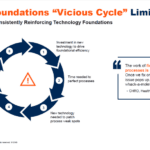In the rapidly evolving landscape of human resources, senior HR leaders are often enticed by the allure of the latest trends and technological innovations. In our work with organizations, we often hear about the pressures to adopt some new, shiny solution or “ways of working” without fully understanding what problem they are supposed to solve. While we agree that staying updated about the newest developments in the industry is crucial, it is equally important to avoid the pitfalls of adopting the latest fads without establishing a solid foundation for transformation.
When working with senior leaders, I spend time understanding their current state and walking them through some specific actions they can take to build a strong foundation for a transformation. This is before signing the contract for that fancy new AI bot.
Understanding the HR transformation landscape
The realm of HR transformation encompasses a broad spectrum of changes, from digitalization and automation to organizational restructuring and talent management. However, the rush to adopt new technologies and methodologies often leads to fragmented efforts, misaligned goals and, ultimately, transformation failures. It is essential to lay a strong foundation before embarking on any major change initiatives to avoid these pitfalls.
The pitfalls of following fads
Adopting the latest HR fads without a strategic approach can lead to several issues:
Resource drain: Investing in trendy solutions without clear benefits can waste valuable time and resources, especially in our current capacity-starved HR environment.
Misalignment: New tools and strategies may not align with the organization’s goals, culture or needs. It’s also possible that this new fad directly conflicts with what the executive leadership team is trying to build.
Employee resistance: Rapid changes can lead to resistance from employees—and senior leaders—who are not prepared or convinced of the benefits.
Transformation fatigue: Constant changes without tangible results can cause employee fatigue and disengagement. It can also impact your credibility for a future transformation crucial to the organization.
Implementation without integration: Too many companies buy or maybe even build a new tool without consideration of how to integrate it into their current technology stack, which leads to inconsistent processes, manual work and data inaccuracies.
5 strategies to kickstart HR transformation
To ensure a successful HR transformation, it is crucial to focus on readiness. Here are five key recommendations for senior HR leadership to build a strong foundation for transformation.
Conduct a thorough assessment
Before embarking on any transformation initiative, conduct a comprehensive assessment of your current HR landscape. We advocate for a forensic-level deep dive into how work is being done at your organization. What does the end-to-end process really look like—both inside and outside your HR systems? What are your pain points? What processes are outdated or inefficient? What cultural or behavioral barriers exist? Without this understanding, any change effort risks being superficial or misaligned.
This overall assessment should include, at a minimum:
Capability analysis: Evaluate the existing capabilities of your HR team, systems and processes.
Gap identification: Identify gaps between current capabilities and future needs.
Readiness evaluation: Assess the readiness of your organization and employees for change.
A thorough assessment provides a clear understanding of where you are and what needs to be addressed before moving forward. It also helps in setting realistic goals and expectations for the transformation journey.
Develop a clear vision and strategy
Transformation without purpose is like building a house without a blueprint. It’s extremely important that you know what it is that the transformation is trying to achieve and why the transformation is necessary. Key activities include:
Defining objectives: Clearly define what you aim to achieve with the transformation. Are you aiming for increased efficiency, better employee experience or enhanced talent acquisition? Do you have technology that is at end of life?
Aligning with business goals: HR leaders of successful transformation take the extra time to align these objectives with the organization’s overall strategy to bolster the business case for change.
Creating a roadmap: This is a critical step that HR often misses. Prioritization and governance are vital to the success of any transformation, and a roadmap—outlining the steps, timelines and milestones—is the outcome of all that work. It will guide the team before, during and after the transformation.
Having a clear vision and strategy ensures that all efforts are aligned and focused, reducing the risk of veering off course of HR transformation due to the allure of new trends.
Lead with change
It is never too early to start thinking about your change strategy. Stakeholder engagement and preparation at all levels of the organization are crucial for the success of any HR transformation initiative. I’ve seen well-intentioned transformations fail not because of the objectives or execution of the technical components but because change was treated as an afterthought.
To avoid this mistake, keep in mind the following:
- Name a change lead: Depending on the scope of your transformation, this role typically cannot be done off the side of someone’s desk. Assign a change lead who oversees the changes impacting the organization and can develop and execute a strategy that communicates the transformation’s vision, benefits and impact to all employees.
- Training and development: Provide necessary training and development programs to equip employees with the skills needed for the new HR landscape. This might be a combination of technical training and behavioral training.
- Involve employees: To foster a sense of ownership and commitment, involve employees in the planning and implementation process. Identify change champions within your organization. These individuals can rally their peers, provide feedback and serve as role models.
Engaging and preparing employees helps in building a supportive culture that is more adaptable to change.
Leverage data and analytics
Data and analytics play a pivotal role in successful HR transformations. Executive sponsors want to see a return on the investment they are making. To leverage data effectively, consider:
Baseline metrics: One of the reasons I struggle with “best practice” metrics is that most organizations don’t even know what their baseline is. So, how do they know what their goals should be? Take the time to establish baseline metrics to measure current performance and track progress. This might be challenging in your current environment, but it will pay off when you can point to positive change.
Data-driven decisions: Transformations can result in some strong emotions. In this charged environment, it’s all too easy to make reactive decisions in the heat of a moment. Encourage all participants to use data to inform decision-making, identify trends and predict outcomes.
Continuous monitoring: Of course, using data to make decisions means having that information readily available. Implement continuous monitoring and feedback mechanisms to assess the effectiveness of the transformation efforts. Dashboards designed with specific populations in mind mean stakeholders can access real-time information whenever they need it.
Data-driven insights enable more informed and strategic decisions, ensuring the transformation is on the right track.
Foster a culture of continuous improvement
Transformation is not a one-time event but an ongoing process. Once the transformation shifts from implementation to maintenance, it can be difficult to muster the enthusiasm to embrace incremental changes vital to ongoing organizational health. To sustain transformation efforts, focus on the following:
Continuous learning: Embracing continuous improvement can often require a mindset shift within an organization. After all, you’ve just gone through what might have been a very rigorous transformation; people are ready for some stability. Consider reframing a culture of “continuous improvement” to something like a culture of continuous learning. This encourages curiosity and growth.
Feedback and prioritization: Establish feedback loops to gather input, evaluate outcomes and make necessary adjustments. If you have a case management system, you can use this as your intake mechanism; otherwise, establish a simple, standard way for stakeholders to submit requests for change. Business process owners and other decision-makers can then evaluate and prioritize this for potential adoption.
Agility and flexibility: As a leader, your reaction to bumps in the road signals how the rest of the organization can react. Embrace the adventure to help your team adapt to changing circumstances and new opportunities.
Fostering a culture of continuous improvement, supported by a governance framework to evaluate and prioritize changes, ensures that the organization remains resilient and responsive to future needs.
From fad to fabulous
HR transformation is a complex and challenging journey that requires careful planning, strategic alignment and a strong foundation. By avoiding the trap of adopting the latest fads and focusing on readiness, senior HR leadership can ensure a more successful and sustainable transformation. Conducting a thorough assessment, developing a clear vision and strategy, engaging and preparing employees, leveraging data and analytics, and fostering a culture of continuous improvement are essential steps in building this foundation. With these recommendations, leaders can navigate the HR transformation landscape effectively and achieve lasting impact for their organizations.
Kimberly Carroll will moderate a panel discussion on the role of program management in transformation at the upcoming HR Technology Conference, which will be held Sept. 24-26. Click here for more information and to register.
The post Transformation readiness: Avoiding the trap of HR fads with a strong foundation appeared first on HR Executive.


